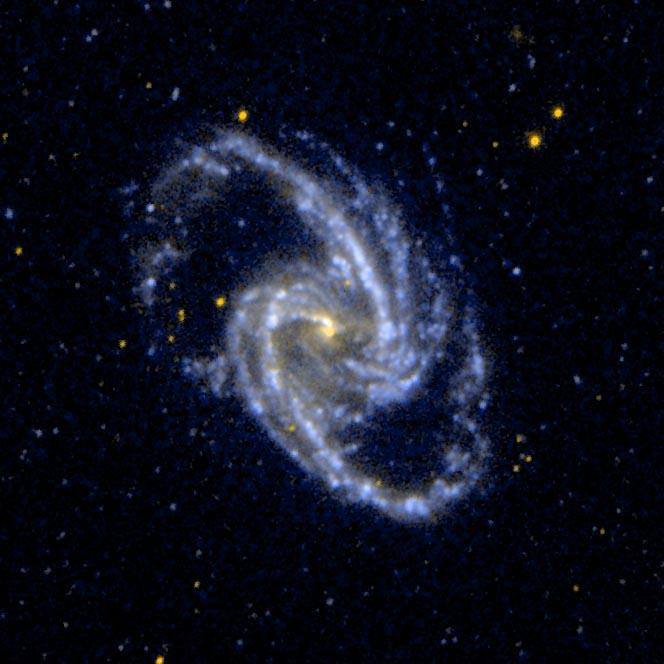Universe-Sized Questions: Dark Matter, Dark Energy, and the Big Bang

Header Image: This is NGC 1365, the barred spiral galaxy a part of the Fornax Cluster. Image Credit: NASA/JPL-Caltech/SSC
Dark matter. What is it? Why can’t we see it? And how is it related to dark energy and the Big Bang?
Every day, we (the astronomers at the Adler Planetarium) get asked curious questions about the universe. When a fan recently emailed us asking for an overview of the Big Bang, dark matter, and dark energy, our astronomer Dr. Geza Gyuk did what he does best—explained those extremely complex topics in a way that blew our minds and left us screaming follow-up questions for days.
Read on to learn about dark matter, dark energy, and the Big Bang, directly from an Adler Planetarium astronomer!
____________________
“Then Nearly 14 Billion Years Ago Expansion Started, Wait…”
Let’s start by describing the expansion of the universe. The expansion is frequently described as an expansion *into* something, sort of like an explosion, where the space is preexisting and matter is flung “out” into the space. This is not what is happening. Instead, the expansion of the universe is really an expansion of space itself. The distances between distant galaxies get larger. The space between objects physically increases like rubber when stretched. That’s the key insight of Einstein’s Theory of General Relativity: space and time are dynamic things that can be stretched and twisted. They are not just stages on which physics and history play out.
If everything is expanding, then why do we notice it? After all, if we were getting larger and our measuring devices were also increasing in size, how could we measure that the distance to faraway galaxies is increasing? The answer is that physical objects, like people and planets and stars and solar systems and even galaxies, are “bound.” That is, they are held together by a force. In the case of people, we are held together by electromagnetism (as chemistry). For a solar system, or the Milky Way Galaxy, or the bound system of the Milky Way Galaxy plus the Andromeda Galaxy, that force is gravity. The key point is that these electromagnetic forces or the gravitational force over smaller distances is “stronger,” in a certain sense, than the force of the expansion of the universe would be at smaller distances. This means that the universe increases in size over time, but bound objects and bound systems do not. Therefore, we only see this expansion as increasing distances between far-flung galaxies. And because our “rulers” are bound, we can use them to measure the ever-increasing space between galaxies.
A Large Rubber Balloon = The Universe
The best analogy I can give, without resorting to the equations themselves, is to visualize the universe as the “surface” of a very large rubber balloon. Bound objects within the universe are like regions of the balloon that are glued. The rubber can’t expand where it is glued so those objects don’t get bigger. Motion through the universe is analogous to moving along the surface of the balloon. In fact, everything physical happens on the surface. Of course, the universe is three dimensional and the balloon surface is only two dimensional, so we’d have to imagine some sort of hyperballoon to have this completely correct, but the general idea can be understood by imagining a 2-D universe.
Imagine objects living on the surface of the balloon. Now imagine the balloon being inflated. As it is inflated the rubber (space) is stretched and gets bigger. Two spots on the balloon will have a greater length of rubber between them. While in this case the 2-dimensional surface of the balloon does expand outwards into 3-d space, this is not really important. What is important is that the distances on the surface get larger. As time goes on the *area* of the balloon increases. If one projects backwards the area of the balloon must have been much much smaller in the past.
Our universe is like the surface of the balloon, but with one more dimension. Project backwards in time and the *volume* of the universe must have been smaller. Far back in time, the volume of the universe was much much smaller and matter was much more densely packed. As it turns out, the equations tell us that as the universe expands, not only does the distance between (unbound) objects increase, but the velocity of the objects also decreases (or in the case of photons of light, the energy decreases). Wind the universe’s clock backwards and you’ll find that in the early universe matter was moving very fast and was very close together: it must have been very, very hot and very, very dense. That is the state we call the Big Bang.
All Kinds Of Matter Matters
In fact, the temperatures and the energy per particle were so high then that matter behaved very differently in the first few moments of the universe. At tremendous energies, matter can actually be created in the collisions between particles. And that is exactly what we think happened. Exotic forms of matter were created that are very different from our familiar protons and electrons and neutrons. And, in fact, more of this “exotic” matter was created than normal matter! And it is still here. All around us.
Why can’t we see 90% of the matter that makes up the universe? Because, in our current low-energy universe, it doesn’t interact with normal matter (or even itself!) in any way except gravitationally. To see it would require electromagnetic interaction, and it doesn’t form planets or stars or anything. We call it dark matter because it is dark and does not shine. It clumps together some, but mostly only at distances that are the sizes of galaxies. So while trillions of particles of dark matter are passing through you every second (yes, right now!) you don’t feel a thing.
The Fuel Of The Universe
Ok, so dark matter is exotic matter formed in great abundance in the early universe…but what is dark energy? To be completely honest, we don’t know.
What we know is that by measuring the 3-D distribution and motions of stars and galaxies, and by calculating how gravity works to tug around matter, we can figure out how much normal matter and dark matter there must be in the universe. We do this by comparing what we see in terms of the motions of the visible matter to the calculations. That gives a specific number for how much matter there is in the universe. This turns out to total about 30% of the so-called “critical density,” with 5% of that being normal matter and 25% being dark matter. But other measurements and calculations show that the density of the universe is pretty close to 100% of the “critical” density. Anything that can make up that 70% difference in density has to be spread out very widely and can’t cluster and clump at all. In fact, it has to behave very differently from normal matter or even dark matter. Instead of generating an attractive force of gravity, it has a repulsive force of gravity. And that repulsive force ought to be making the expansion rate of the universe speed up instead of slowing down. And that is what we see by looking at the most distant objects in the universe. The universe is expanding faster now than it was 5 billion years ago.
Our evidence for dark matter and dark energy is actually very extensive and convincing across many, many measurements of very different types, such as the motions of galaxies and stars and clusters of galaxies, the abundance of particular types of chemical elements, the bending of light from distant galaxies, the patterns of brightness in the microwave background radiation, the distribution of galaxies in space, the speed of recession of supernovae in galaxies out to the edge of the observable universe…all of these are part of the observations that support this consensus cosmological model.
TLDR;
To summarize: Dark matter helps normal matter clump up and form galaxies. Dark energy fuels the expansion of the universe. And the early universe was very, very hot and very, very dense. It’s complicated, but explainable!
One of the science goals of the JWST* is to help us refine our understanding of the early universe by imaging and studying distant galaxies. We can’t wait to see what we can learn!
*In our blogs and other materials, we use the acronym JWST rather than the full phrasing James Webb Space Telescope in acknowledgement of the concerns around James Webb’s actions as a NASA agency administrator in the 1960s that contributed to the “Lavender Scare” targeting LGBTQ people in government at the time. If you would like to learn more about this topic, please read this article.
Are Ghosts Made Of Dark Matter?
Is dark matter’s cosmic web like a spider’s web? What happens when an astrophysicist (Dr. Geza Gyuk) and a bedbug expert walk into a panel discussion together? If ghosts are not made of feathers and hot dogs and the internet, are they made of dark matter? If dark matter could talk, would it tell us humans that it is tired of us telling it what it is? Watch the Wow! Signal—our lightly educational space comedy sketch show for adults—and laugh along with us as we explore one of the most mysterious mysteries of the universe…dark matter!






